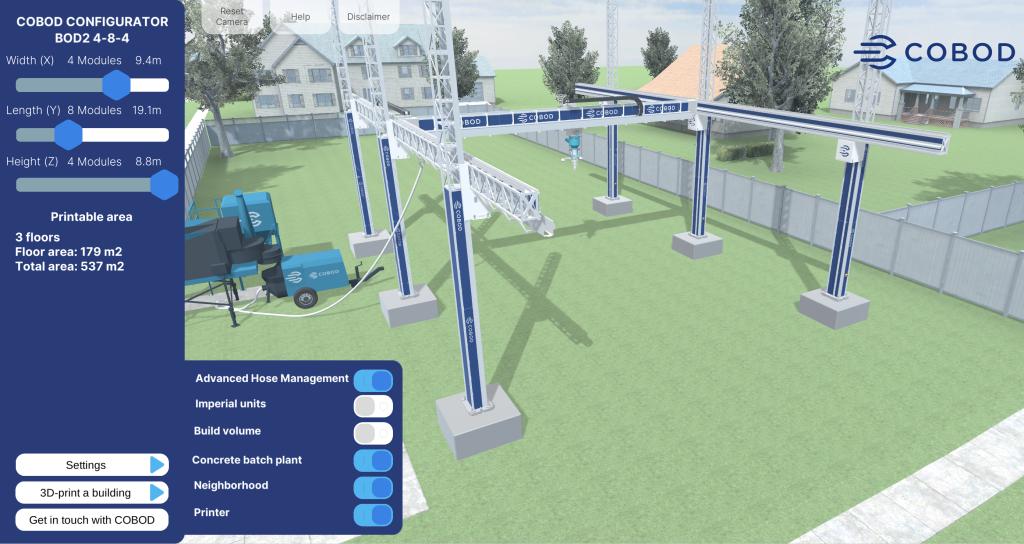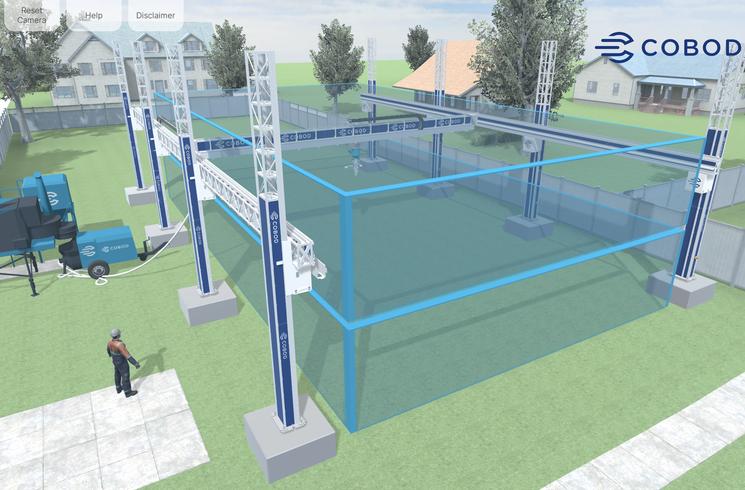
Construction additive manufacturing specialist COBOD has launched a new application that enables users to configure their own concrete 3D printer.
Appropriately named the COBOD Configurator, the firm’s software is designed to not only allow anyone with a computer or smartphone to set up and virtually simulate the construction of a 3D printed home, but those with an eye for the technology to experiment with its modularity, and reach out to put it into practice.
The BOD2’s disruptive potential
Over the last five years, COBOD has established itself as one the early leaders in the emerging construction 3D printing space. In order to achieve its wider goal of disrupting the global construction industry, the firm continues to develop its BOD platform, launching the BOD2 in 2018, a gantry-mounted 3D printer it now markets in three iterations.
Each version of the system is composed of 2.5-meter modules, which can be stacked on its X, Y and Z axes to enable the erection of multi-storey structures, with floors up to a size of 12m (W) x 27m (L) x 9m (H). Newer models are also said to feature a re-engineered tangential nozzle, which provides users with greater control over the quality and texture of walls, reducing the need to post-treat them.
In practice, the modular 3D printer has been applied to build structures of all shapes and sizes since the erection of its first habitable 3D printed building in Copenhagen. For instance, GE Renewable Energy and LafargeHolcim have committed to using the technology to create a record-tall wind turbine tower, while part-owner PERI has utilized it in multiple builds, including that of a 3D printed German apartment block.
More recently, COBOD has fostered a partnership with Mexican building material specialist CEMEX as well, which has yielded a novel concrete that ‘gains shape instantaneously.’ Leveraging this new formulation, the companies have already built Angola’s first 3D printed home and a three-bed home in Oman, the latter of which they claim to be the largest additive manufactured from ‘real’ concrete.
Accessible concrete 3D printing?
Using the COBOD Configurator for the first time, it’s difficult to initially tell whether it’s designed to meet the needs of its existing clientele, or attract the attention of an entirely new audience. In essence, the software allows users to tweak the settings of a simulated BOD2 3D printer, before deploying whichever setup they’ve opted for to build an entire computer-generated home from scratch.
Within the configurator, wannabe and qualified engineers alike are able to choose the width, length and height of their virtual, modular COBOD system. In doing so, users can build anything from a 2 x 2 x 2 module machine capable of erecting a 184 sq. ft flat, to a fully-fledged 5 (W) x 20 (L) x 4 (H) module unit, with the ability to produce three-storey structures featuring a floor area of up to 6,327 sq. ft.

For those seeking the most realistic representation of the BOD2 in-action, the 3D printer itself, as well as its concrete mixing facilities, hose management setup and the application’s build volume indicator, can also be turned off in the settings, but its simulated ‘neighborhood’ feature seems (on the surface at least) to only be there for appearance’s sake.
Likewise, rather than allowing users to design and build a house of their own, the software limits them to constructing one of those it has already built, or a pre-designed model that’s in the works. While this may be a handy way for interested parties to understand what’s been done before, and offers up a healthy range of use cases, it’s hard to not see the feature as a missed opportunity.
That being said, the depth of the application’s configuration options should be more than enough to satisfy those with a passing interest in the technology. Whether that intrigue can convince those with deep enough pockets to put what they’ve learned into practice, is another question, but as it stands, the software at least constitutes a fun, visually-engaging way to learn about construction 3D printing.
Available in the form of both a browser-based web application and apps on the iOS and Android stores, the COBOD Configurator can now be accessed free of charge.
COBOD’s construction competitors
Although COBOD is no doubt one of those at the forefront of concrete 3D printing, the technology still has a long way to go before it can disrupt the mainstream construction industry. The company doesn’t exactly have a monopoly on the process either, and the likes of ICON has even managed to attract over $460 million in funding, to fund the development of its own take on the technology.
At a less commercialized level, a large number of start-ups and university teams are also experimenting with concrete additive manufacturing, yielding some impressive results. Over in Japan, for example, Serendix Partners is said to have 3D printed a spherical house inside 24 hours, that’s small but robust enough to meet the country’s demanding earthquake-proofing standards.
In Dubai, on the other hand, eco-friendly construction specialist WASP 3D printed a coastal pop-up Dior shop late last year, to showcase some of the fashion house’s collections. Using its proprietary Delta 3D printers, the firm found it was able to deposit a combination of clay, sand and raw fibers into layers, to form a stable (yet on-brand) beachside store.
To stay up to date with the latest 3D printing news, don’t forget to subscribe to the 3D Printing Industry newsletter or follow us on Twitter or liking our page on Facebook.
For a deeper dive into additive manufacturing, you can now subscribe to our Youtube channel, featuring discussion, debriefs, and shots of 3D printing in-action.
Are you looking for a job in the additive manufacturing industry? Visit 3D Printing Jobs for a selection of roles in the industry.
Featured image shows the new COBOD Configurator application. Photo via COBOD.